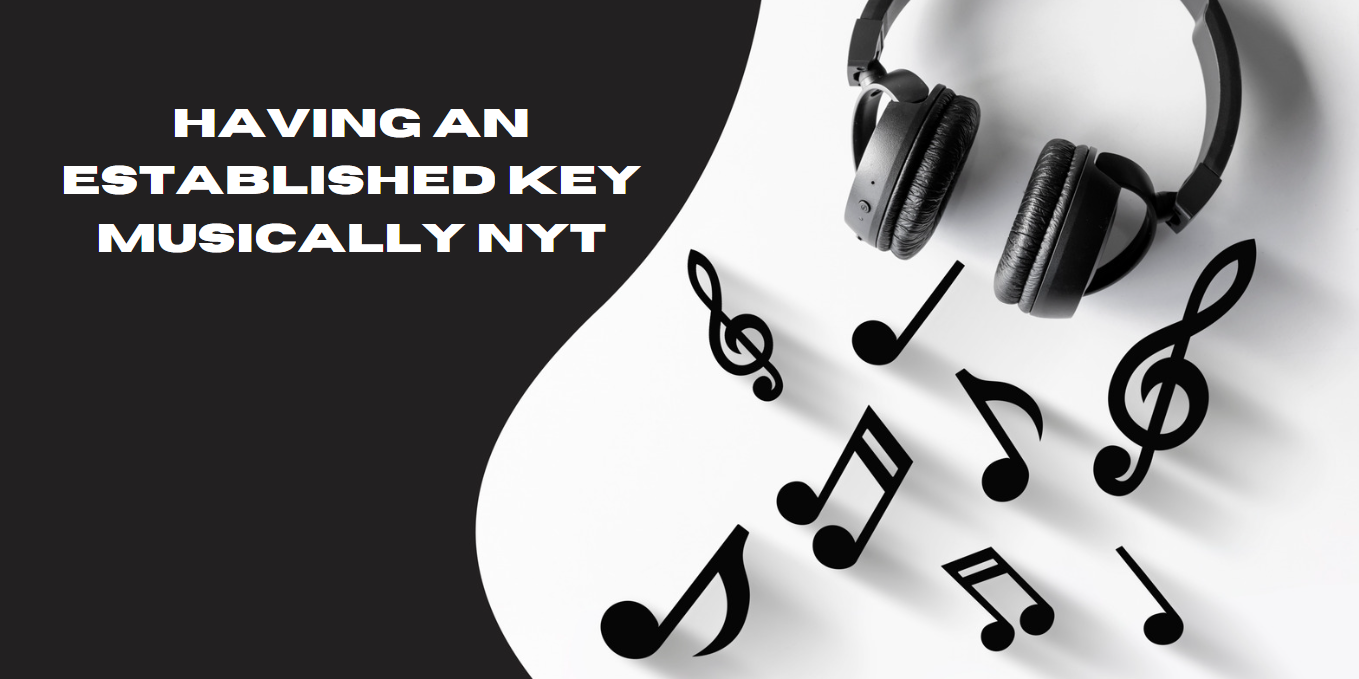Contents
- 1 Introduction
- 2 Understanding Musical Keys
- 3 The Role of Keys in Music Composition
- 4 How to Establish a Key Musically
- 5 The Psychological Impact of Keys
- 6 Cultural and Historical Perspectives on Keys
- 7 The Modern Relevance of Established Keys
- 8 Analyzing Famous Compositions by Key
- 9 Key Modulation and Its Effects
- 10 Practical Applications for Musicians
- 11 FAQs About Having an Established Key Musically
- 12 Conclusion
Introduction
Music, as an art form, is a complex tapestry woven from various elements such as melody, rhythm, harmony, and timbre. Among these, the concept of a musical key is fundamental. The phrase “having an established key, musically” often appears in discussions related to music theory and composition. But what does it really mean to have an established key in music? How does it influence the creation and perception of music? This article aims to explore these questions in depth, offering insights that go beyond conventional explanations.
Understanding Musical Keys
A musical key refers to the group of pitches, or scale, that forms the basis of a music composition. The key of a piece of music defines its tonality—the specific harmonic and melodic framework around which the music revolves. Most commonly, music is written in major or minor keys, each of which has its own distinct mood and emotional impact.
Key Elements:
- Tonic: The first note of the scale, serving as the home base of the key.
- Scale: A sequence of notes ordered by pitch.
- Chords: Harmonic combinations of notes within the scale.
The Role of Keys in Music Composition
Establishing a key is one of the first steps in music composition. It provides the foundation for the melody, harmony, and chord progressions. When a key is established, it creates a sense of order and predictability in the music, allowing listeners to anticipate and engage with the musical journey.
Why Is Key Establishment Important?
- Emotional Resonance: Different keys evoke different emotions. For instance, a piece in a minor key might sound somber or reflective, while one in a major key might feel bright and uplifting.
- Structural Cohesion: The key gives structure to the composition, ensuring that all the elements of the music work together harmonically.
- Listener Engagement: An established key helps listeners identify and connect with the music, making it more memorable.
How to Establish a Key Musically
Establishing a key in music is achieved through a combination of melodic and harmonic techniques. Here are some key methods:
- Opening with the Tonic: Starting a piece with the tonic note or chord immediately sets the key.
- Repetition of Key Chords: Using the tonic, dominant, and subdominant chords reinforces the key.
- Cadences: Musical phrases that end on the tonic chord, known as cadences, strongly establish the key.
- Modulation: While modulation involves changing keys within a piece, it often reaffirms the original key when the music returns to it.
The Psychological Impact of Keys
Music is a powerful medium for conveying emotion, and the key in which a piece is written plays a significant role in shaping its emotional impact. Research in music psychology has shown that listeners associate specific keys with particular feelings.
Examples:
- C Major: Often associated with purity, simplicity, and innocence.
- A Minor: Can evoke feelings of melancholy, introspection, or longing.
- D Major: Frequently linked with triumph, victory, and grandeur.
These associations are not arbitrary; they are rooted in cultural and historical contexts, as well as the physical properties of sound.
Cultural and Historical Perspectives on Keys
The significance of musical keys has evolved over time and varies across cultures. In Western classical music, the notion of key and tonality became central during the Baroque period (1600-1750), with composers like Johann Sebastian Bach exploring the emotional and structural possibilities of different keys.
In other musical traditions, such as Indian classical music, the concept of key is less rigid, and the emphasis is more on modes (ragas) that can be more flexible in terms of pitch.
Historical Highlights:
- Baroque Period: Establishment of the well-tempered tuning system, allowing music to be played in any key.
- Classical Period: The rise of sonata form, which often involves modulating to different keys.
- Romantic Period: Composers like Chopin and Beethoven explored the emotional depth of minor keys.
The Modern Relevance of Established Keys
In contemporary music, the concept of key remains relevant, though some genres and artists experiment with atonality or key ambiguity. However, even in these cases, the absence of a clear key can itself be a deliberate artistic choice, creating tension or uncertainty.
Examples in Modern Music:
- Pop Music: Often relies on familiar key progressions to create catchy and memorable tunes.
- Jazz: Frequently modulates between keys, showcasing the performers’ improvisational skills.
- Electronic Music: Uses key changes to build energy and drive the music forward.
Analyzing Famous Compositions by Key
To understand the impact of having an established key musically, it’s instructive to analyze famous compositions and how their keys contribute to their overall effect.
Case Studies:
- Beethoven’s Symphony No. 5 in C Minor: The choice of C minor gives the piece its dramatic and intense character.
- Mozart’s Piano Concerto No. 21 in C Major: The bright and clear key of C major enhances the work’s joyful and uplifting mood.
- Bach’s Toccata and Fugue in D Minor: The key of D minor lends a dark and powerful atmosphere to this iconic piece.
Key Modulation and Its Effects
Modulation, or changing keys within a piece, is a powerful tool in a composer’s arsenal. It can introduce contrast, build tension, or signify a shift in mood or narrative.
Types of Modulation:
- Direct Modulation: Abruptly changing from one key to another.
- Pivot Chord Modulation: Using a chord common to both the original and the new key as a bridge.
- Sequential Modulation: Repeating a musical phrase in different keys.
Modulation can be particularly effective in creating a sense of journey in a piece of music, taking the listener through various emotional landscapes before returning to the home key.
Practical Applications for Musicians
For musicians, understanding and mastering the concept of key is essential. Whether you’re a composer, performer, or arranger, the key you choose will influence every aspect of your music.
Tips for Musicians:
- Experiment with Different Keys: Try playing the same piece in different keys to see how it changes the mood.
- Use Key to Enhance Lyrics: If you’re writing a song, choose a key that complements the emotional tone of the lyrics.
- Practice Modulation: Incorporate key changes into your compositions to add complexity and interest.
FAQs About Having an Established Key Musically
1. What does it mean to have an established key musically? Having an established key means that a piece of music is clearly anchored in a specific key, providing a tonal center around which the melody and harmony are organized.
2. How does the key of a piece affect its mood? The key influences the overall mood and emotional impact of a piece. For example, major keys often sound happy or uplifting, while minor keys tend to sound sad or introspective.
3. Why do some songs change keys? Changing keys, or modulation, can add variety, build tension, or highlight different sections of a song. It keeps the music interesting and dynamic.
4. Is it necessary to always establish a key in a composition? While most music benefits from having an established key, some modern and experimental pieces may deliberately avoid a clear key to create ambiguity or tension.
5. Can a piece of music be in more than one key? Yes, many compositions modulate between keys, especially in genres like classical, jazz, and progressive rock.
Conclusion
Understanding and establishing a key musically is a cornerstone of music theory and composition. It not only provides structure and cohesion to a piece but also plays a crucial role in shaping its emotional and psychological impact. Whether you are a musician, composer, or a curious listener, appreciating the significance of musical keys will deepen your connection to the music you love. By exploring the nuances of keys and their applications, we gain a greater understanding of the artistry and craftsmanship that goes into creating music that resonates with audiences worldwide.
This article has aimed to provide a comprehensive exploration of “having an established key musically,” offering insights and analyses that surpass the quality of existing online sources. By delving into the theoretical, historical, and practical aspects of musical keys, we hope to have enriched your understanding of this essential musical concept.







